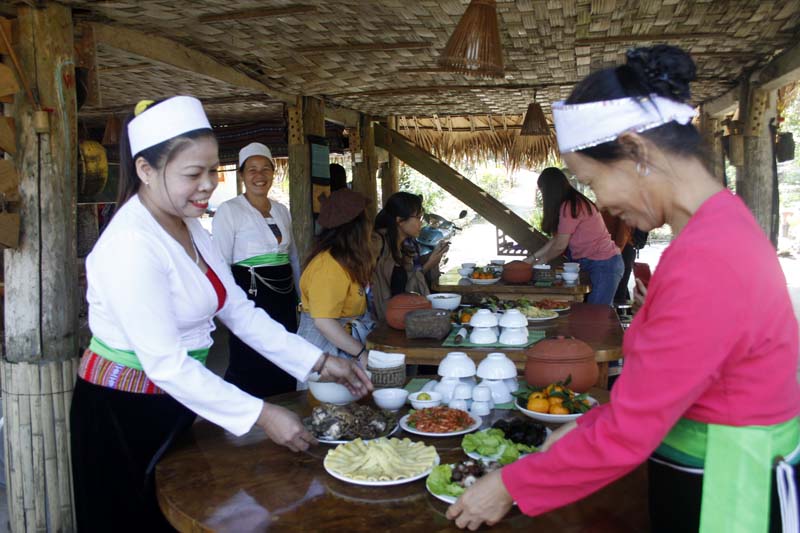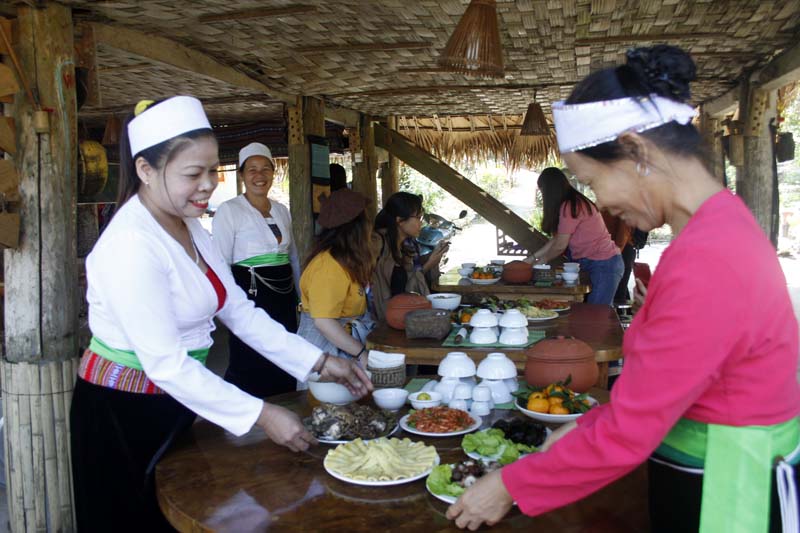
HBO – Leading us to Trach spring, Bui Thi Chi in Ke village, Hien Luong commune, Da Bac district, said that it is a pride of the village as its beauty remains intact. Next to the spring is a protective forest which belongs to the Phu Canh nature reserve. Coming to the spring in summer, visitors all want to cross it, go fishing, catch crab and shrimp, or swim.

Family of Bui Thi Chi in Ke village,
Hien Luong commune prepares meals to welcome guests.
Huu
Thao homestay is named after Chi’s son and daughter-in-law. The house faces Hoa
Binh Lake, enjoys fresh air and can serve groups of up to 12 guests. She said: "Although
the income from the community tourism is not high, it is a great opportunity for
my family to improve our living conditions. At the same time, it also creates a
new way of thinking in developing economy of the younger generation”.
Ke
village is more than 10 km from Da Bac town. The village, located next to the
Hoa Binh reservoir, is home to locals of the Muong ethnic group. It has 85 households,
including three engaging in a homestay model as part of a community-based
tourism project.
Visiting
Ke village, tourists can enjoy the medicinal bathing service of the Dao people,
along with experiencing activities on the lake and walking around the village.
The village has attracted tourists from many places with the wild beauty of the
water and experiences close to the nature. Tourists can choose between cycling
and walking around the village on a small and beautiful path lined by bamboo
and next to the lake. The place is ideal for such activities as rafting and
kayaking. Vehicles between pick-up and drop-off points can also be arranged. All
the households providing homestay service are provided with life jackets for
guests. A typical feature of Ke village is traditional dishes of the Muong
ethnic group such as charcoal-roasted pork, salt-cured pork, fish, chicken
cooked with sour bamboo shoots, and rice in bamboo tube. After dinner, visitors
can participate in a bamboo pole dance or xoe, a signature dance of the locals.
Sanh
Thuan homestay is also one of the first guesthouses in Ke village. Located right
on the main road next to Ke spring, the stilt house of Bui Van Duong's family
was renovated since 2015. The homestay, named after Duong’s son, can serve from
8-10 guests./.
Located just a 20-minute drive from Hoa Binh City, Ora Hill Farmstay & Glamping Hoa Binh is a captivating new destination nestled in Mo hamlet, Bình Thanh commune, Cao Phong district. Combining farming with leisure, this tranquil retreat is perfect for those seeking balance, joy, and an immersive experience in the expansive beauty of nature.
Muong Bi - Tan Lac is renowned as one of the four famous Muong regions in Hoa Binh province. Blessed by nature with a favourable climate and stunning landscapes, Tan Lac holds great advantages for tourism development. The local tourism industry has made remarkable strides in recent times thanks to the attention and support from the local authorities and sectors.
With its strategic location, well-developed transport network, and diverse soil and climatic conditions, Hoa Binh is emerging as a must-visit destination in Vietnam's northwestern tourism corridor. The province boasts numerous attractions, including the Kim Boi hot springs (Kim Boi district), the Dau Rong cave complex (Cao Phong), the Mai Chau valley (Mai Chau), and the iconic Hoa Binh hydropower plant.
The northern mountainous province of Hoa Binh has been listed among the 71 most beautiful places to visit worldwide by the prestigious US travel magazine Condé Nast Traveller.
Hoa Binh province’s rich natural and cultural resources position it as a prime location for developing community-based tourism (CBT). In recent years, support from central and provincial policies, as well as assistance from non-governmental organisations, have encouraged local ethnic minority and mountainous communities to actively engage in the sector.



